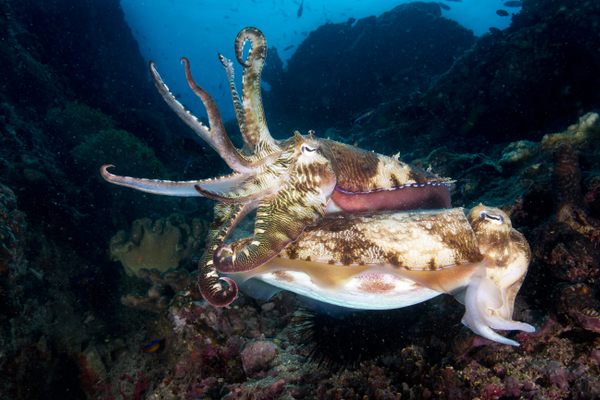Will There Ever Be an Anglerfish Emoji?
Two researchers are hoping to diversify our chief communicative ecosystem.

Consider the anglerfish. It’s a type of bony fish that has been around since the early Cretaceous. It is best known for the fleshy protrusion on its head, which it uses to entice prey, and which sometimes is inhabited by glowing bacteria, for extra luring power. Its mating habits are also distinct: In some species, the female is dozens of times larger than the male, which literally merges with her side and provides her with sperm in exchange for nutrients from her blood.
Odds are you have not been lucky enough to personally encounter an anglerfish, as most live way down in the deepest parts of the ocean, thousands of feet below the surface. But if two researchers have their way, you might eventually be able to find it someplace much nearer to hand: your phone.

The emoji menagerie is necessarily more limited than the real world. After all, no one wants to scroll past 20,000 different tiny butterflies to get to the all-important “the G train is late again” snail. But even so, the biodiversity there leaves something to be desired. As experts have pointed out, the “Animals & Nature” set skews towards creatures most people are already familiar with; even with the recent addition of the cricket and the sauropod, the vast majority—about two-thirds—are mammals. If you used it as a guide to fill an ark, the post-flood Earth would be pretty boring.
Earlier this week, Andrew Thaler and Amy Freitag submitted a proposal to Unicode in an attempt to add the anglerfish to next year’s official emoji set. Both are ocean scientists: Thaler is a deep-sea ecologist, while Freitag is a sociologist who studies coastal communities. They also happen to be a married couple, and the parents of a daughter who shares many of their marine enthusiasms. As such, they were partly motivated by sheer need. Thaler describes them as “kind of an anglerfish family,” and Freitag says the couple often found themselves bemoaning the limitations of the platform, “joking about making different kinds of emojis and not being able to find the ones we wanted to use.”

But this dissatisfaction gained another dimension this past fall, when Thaler decided to challenge his college roommate, the shark biologist David Shiffman, to a sea-themed, all-emoji round of Twitter chess. He had barely begun setting up the board when he ran into a problem. “I realized there are only 11 emojis for all ocean creatures,” he says. This was an issue for the chess game, which needed a dozen discreet species to stand in for each of the different pieces.
Thaler ended up deputizing a couple of penguins as rooks—and mixed things up further with the “snail” and “spiral shells” glyphs—and the game was a salty success. But a larger concern remained. “Most of the biodiversity in the world is in the oceans,” he says. “Only a tiny, tiny fraction of that is represented by these 11 emojis, two of which are whales.”
Game on, @WhySharksMatter, game on.
— Andrew Thaler (@DrAndrewThaler) November 10, 2017
8🐧🐬🐡🐠🐳🐡🐬🐧
7🦈🦈🦈🦈🦈🦈🦈🦈
6✖️✖️✖️✖️✖️✖️✖️✖️
5✖️✖️✖️✖️✖️✖️✖️✖️
4✖️✖️✖️🦀✖️✖️✖️✖️
3✖️✖️✖️✖️✖️✖️✖️✖️
2🦀🦀🦀✖️🦀🦀🦀🦀
1🐚🦐🦑🐙🐌🦑🦐🐚
Unicode accepts proposals for new emoji during a set period each year. So Thaler and Freitag decided to put forth a deep-sea ambassador. They began brainstorming candidates based on Unicode’s stated values, including how frequently it might be used, whether it broke new ground, and how distinct it was when shrunk down to a few dozen pixels. “We triaged to to find the animals that hit the sweet spot,” says Thaler. The anglerfish, they say, was an obvious choice.
If it makes the cut, this will make family communication easier. But they’re also gunning for a bigger impact. “Once an emoji is approved, it’s now part of this global iconographic lexicon—the only language in the world that is standardized across all countries and all platforms,” Thaler points out. “Now you have a word in a universal language, [and] that can be an incredibly powerful thing for communicating ideas and talking to people across cultures.” Others pictograph-proposers—from well-known brands to the creators of the recently released sticker set “Climoji”—have expressed similar hopes.
Plus, Freitag adds, emojis are hot right now. “People are talking about the whole thing as a cultural moment,” she says. “It would be great to have a conservation message in there.” (They’ve also got a second proposal in the works: a puffin, to help rectify a similar shortage of Arctic creatures.)

For the moment, this is all hypothetical. “It takes a year to get an emoji approved,” Thaler says. “We’re right at the very beginning… there’s no guarantee that there will ever be an anglerfish emoji other than in our hearts and in our souls.”
If it does make it to our fingertips, bets are still off. It’s possible that everyone would simply use the anglerfish emoji to talk about anglerfish, or to discuss the importance of protecting unique ecosystems of the deep ocean. But part of the fun of emojis is how easily they are repurposed for more oblique messaging. It’s not hard to imagine this one filling some less literal communicative needs.
“This is precisely the image we’ll need more and more during our ongoing descent into the abyss,” one Twitter user, Alan Dove, wrote in response to the announcement. Thanks to the anglerfish’s unusual reproductive strategy, “it can represent the parasitic male,” Freitag says, something they pointed out in their application. Or imagine: Late one night, your friend texts you a philosophical thought. Half-flippantly, you respond with a little anglerfish: “Deep.”















Follow us on Twitter to get the latest on the world's hidden wonders.
Like us on Facebook to get the latest on the world's hidden wonders.
Follow us on Twitter Like us on Facebook